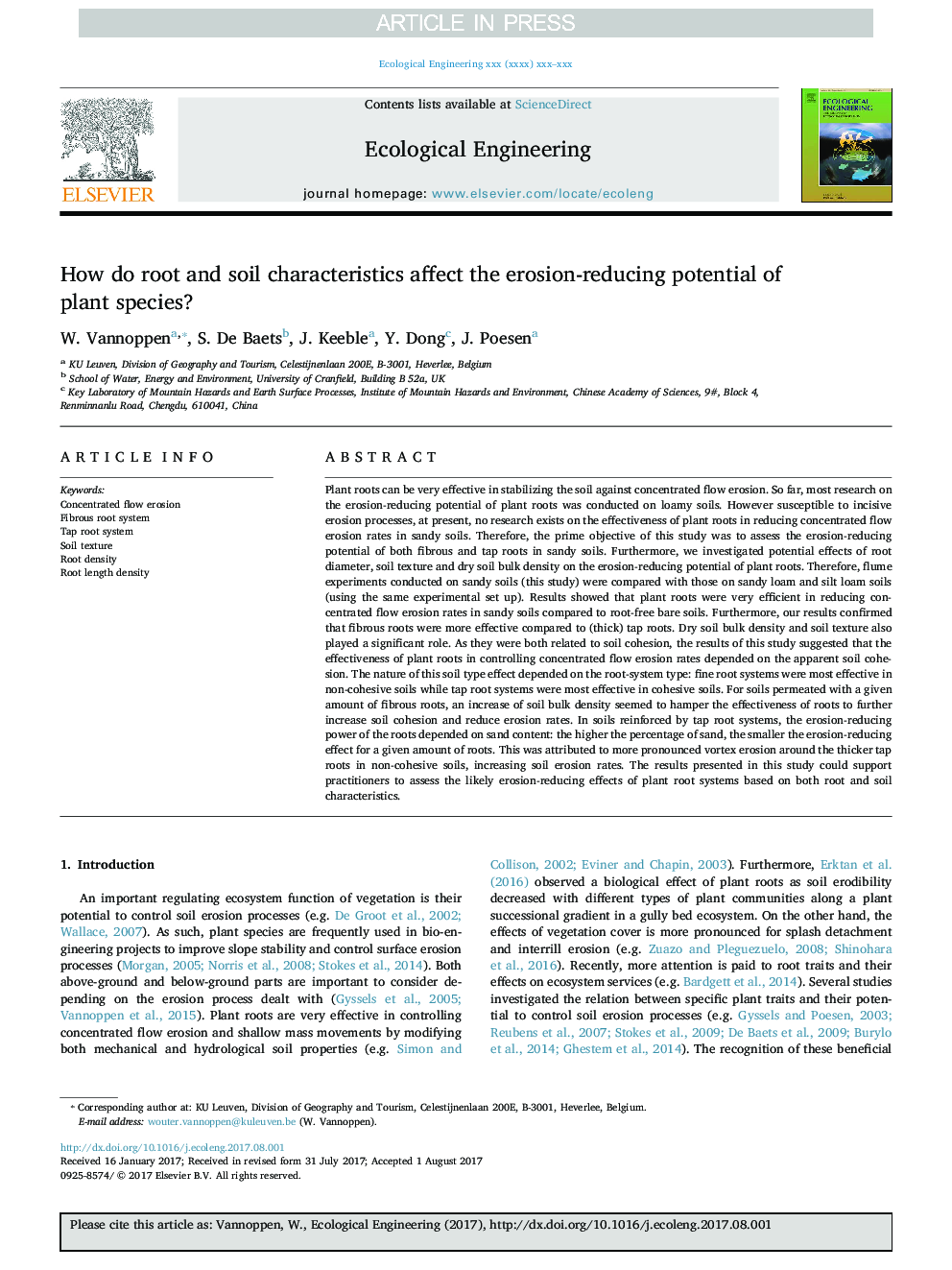| کد مقاله | کد نشریه | سال انتشار | مقاله انگلیسی | نسخه تمام متن |
|---|---|---|---|---|
| 8848158 | 1617993 | 2017 | 10 صفحه PDF | دانلود رایگان |
عنوان انگلیسی مقاله ISI
How do root and soil characteristics affect the erosion-reducing potential of plant species?
ترجمه فارسی عنوان
چگونه ریشه ها و ویژگی های خاک بر پتانسیل کاهش فرسایش گونه های گیاهی تاثیر می گذارد؟
دانلود مقاله + سفارش ترجمه
دانلود مقاله ISI انگلیسی
رایگان برای ایرانیان
کلمات کلیدی
فرسایش جریان متمرکز، سیستم ریشه فیبر، شیر سیستم ریشه، بافت خاک، تراکم ریشه، تراکم طول ریشه
ترجمه چکیده
ریشه گیاهان در ایجاد ثبات خاک در برابر فرسایش جریان متقابل می تواند بسیار موثر باشد. تا کنون، بیشتر تحقیقات در مورد پتانسل کاهش فرسایش ریشه گیاهان بر روی خاک های لومیا انجام شده است. در حال حاضر هیچ اثری بر اثربخشی ریشه های گیاه در کاهش جریان فرسایش جریان متمرکز در خاک های شنی وجود ندارد. بنابراین هدف اصلی این مطالعه، ارزیابی پتانسیل کاهش فرسایش ریشه های فیبروی و ریشه در خاک های شیلی بود. علاوه بر این، اثرات بالقوه قطر ریشه، بافت خاک و چگالی خاک خشک خاک بر پتانسیل فرسایش ریشه گیاهان مورد بررسی قرار گرفت. بنابراین، آزمایشات فلویم در خاکهای شیلی (این مطالعه) با مقادیر لوم ماسه ای و لوم خاک (با استفاده از همان آزمایش آزمایشگاهی) مقایسه شد. نتایج نشان داد که ریشه گیاهان در کاهش میزان فرسایش جریان متمرکز در خاک های شنی در مقایسه با خاک های لخت بدون ریشه بسیار موثر بودند. علاوه بر این، نتایج ما تایید کرد که ریشه های فیبری نسبت به ریشه های (ضخیم) شیر موثر تر است. چگالی خاک خشک و بافت خاک نیز نقش مهمی ایفا کردند. همانطور که هر دو مربوط به همبستگی خاک بودند، نتایج این مطالعه نشان داد که اثربخشی ریشه های گیاهی در کنترل جریان فرسایش جریان متناوب بستگی به انطباق ظاهری خاک دارد. ماهیت این اثر نوع خاک بستگی به نوع سیستم ریشه دارد: سیستم های ریشه های ریز در خاک غیر انسانی موثر بودند، در حالی که سیستم های ریشه شیر بیشتر در خاک های همجوار موثر بودند. برای خاکهایی که دارای مقدار مشخصی از ریشه های فیبری هستند، افزایش تراکم فله خاک به نظر می رسد که اثربخشی ریشه ها را برای افزایش انعطاف پذیری خاک کاهش می دهد و باعث کاهش میزان فرسایش می شود. در خاک های تقویت شده توسط سیستم های ریشه شیر، قدرت فرسایش کاهش ریشه ها بستگی به محتوای شن و ماسه دارد: بیشتر درصد شن و ماسه، کوچکتر اثر فرسایش برای مقدار مشخص ریشه. این امر به فرسایش شدید گرداب در اطراف ریشه های ضخیم تر در خاک های غیر انسانی نسبت داده می شود و باعث افزایش میزان فرسایش خاک می شود. نتایج ارائه شده در این تحقیق می تواند از تمرینکنندگان برای ارزیابی اثرات احتمال بروز فرسایش سیستم های ریشه های گیاهی بر اساس ویژگی های ریشه و خاک حمایت کند.
موضوعات مرتبط
علوم زیستی و بیوفناوری
علوم کشاورزی و بیولوژیک
بوم شناسی، تکامل، رفتار و سامانه شناسی
چکیده انگلیسی
Plant roots can be very effective in stabilizing the soil against concentrated flow erosion. So far, most research on the erosion-reducing potential of plant roots was conducted on loamy soils. However susceptible to incisive erosion processes, at present, no research exists on the effectiveness of plant roots in reducing concentrated flow erosion rates in sandy soils. Therefore, the prime objective of this study was to assess the erosion-reducing potential of both fibrous and tap roots in sandy soils. Furthermore, we investigated potential effects of root diameter, soil texture and dry soil bulk density on the erosion-reducing potential of plant roots. Therefore, flume experiments conducted on sandy soils (this study) were compared with those on sandy loam and silt loam soils (using the same experimental set up). Results showed that plant roots were very efficient in reducing concentrated flow erosion rates in sandy soils compared to root-free bare soils. Furthermore, our results confirmed that fibrous roots were more effective compared to (thick) tap roots. Dry soil bulk density and soil texture also played a significant role. As they were both related to soil cohesion, the results of this study suggested that the effectiveness of plant roots in controlling concentrated flow erosion rates depended on the apparent soil cohesion. The nature of this soil type effect depended on the root-system type: fine root systems were most effective in non-cohesive soils while tap root systems were most effective in cohesive soils. For soils permeated with a given amount of fibrous roots, an increase of soil bulk density seemed to hamper the effectiveness of roots to further increase soil cohesion and reduce erosion rates. In soils reinforced by tap root systems, the erosion-reducing power of the roots depended on sand content: the higher the percentage of sand, the smaller the erosion-reducing effect for a given amount of roots. This was attributed to more pronounced vortex erosion around the thicker tap roots in non-cohesive soils, increasing soil erosion rates. The results presented in this study could support practitioners to assess the likely erosion-reducing effects of plant root systems based on both root and soil characteristics.
ناشر
Database: Elsevier - ScienceDirect (ساینس دایرکت)
Journal: Ecological Engineering - Volume 109, Part B, December 2017, Pages 186-195
Journal: Ecological Engineering - Volume 109, Part B, December 2017, Pages 186-195
نویسندگان
W. Vannoppen, S. De Baets, J. Keeble, Y. Dong, J. Poesen,
